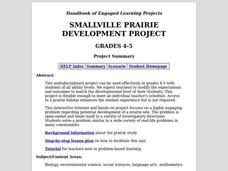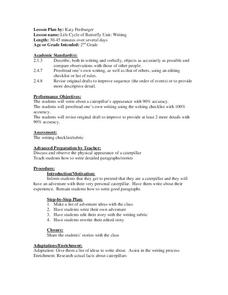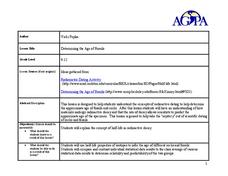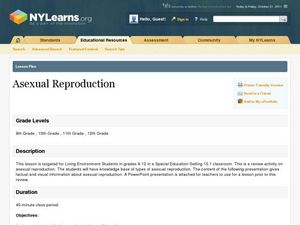Curated OER
Space Exploration Missions
Eighth graders explore and discuss the various space exploration missions. In this space mission lesson students work in pairs and create a PowerPoint presentation on the contributions of space exploration missions.
Curated OER
Explosive Ideas!
Students explore the layers of the Earth and the dynamic changes that they cause on Earth's surface. Volcanoes and earthquakes become the focus of the lesson plan as the Oregon State quarter and its Crater Lake images are linked to the...
Curated OER
Smallville Prairie Development Project
Students, through group activities, explain the important scientific, social/historical and aesthetic values of a prairie habitat. They analyze the impact of humans on prairieland and solve a problem regarding potential development of a...
Curated OER
Smallville Prairie Development Project
Students research the characteristics of the prairie habitat focusing on scientific, social/historical and aesthetic values. They investigate how humans impact the prairie habitat while maintaining a daily journal of research and...
Curated OER
Biocomplexity Research: Wanted: Biocomplexity Scientist
Students use the internet to research and create a Biography of a Biocomplexity Scientist. They name one scientist that they have investigated in the past few years and explain what they did. Students are given a list of 30 scientists...
Curated OER
Kitty Tunes
Students compare cat calls. For this wildlife lesson, students listen to cat calls and compose their own raps that feature the calls of Florida panthers.
Curated OER
Life Cycle of Butterfly
Second graders investigate life cycles of insects by writing a story. In this butterfly life lesson, 2nd graders create a checklist of the many steps a caterpillar takes before growing wings and flying. Students utilize creative...
Curated OER
Send Me A Postcard From The Rainforest
Students research the different regions of the rainforest by using the Internet. They create their own postcards from each region they examine showing the plants and animals of that region. They share their postcards with the class.
Curated OER
Animal Research Project
First graders are introduced to the topic of researching by the librarian. Using a worksheet, they use various sources in the library to choose one animal from various groups. They complete a fact sheet on each animal and report their...
Curated OER
Determining the Age of Fossils
Students examine the concept of radioactive dating. In this radioactive dating lesson plan, students investigate how to determine the ages of fossils and rocks as they learn about half-life radioactive decay.
Curated OER
Using a Thermometer
First graders use their senses to formulate questions and make predictions to determine what is in the "Wonder Bag". They hold pieces of ice and examine while listing descriptors on a chart and then take their own temperature using an...
Curated OER
Wild Thing!
Sixth graders view several segments of the video, "How Animals Survive." They discuss elements of survival. Students list living and nonliving things found in their backyards and schoolyards. Students work in groups to complete the...
Curated OER
Classification of Pasta, Rice and the Nine Planets
Eighth graders create a classification system of the planets and give a written rational for their choice of categories. In this investigative lesson students participate in an activity that helps them to explore classification.
Curated OER
Asexual Reproduction
Sixth graders investigate how asexual reproduction produces single-parent offspring. They use plants and yeast to demonstrate vegetative propagation and budding in a laboratory. Students draw five different types of asexual reproduction.
Curated OER
The Moving Continents from Pangaea to the Future
Eighth graders examine how the movements of the Earth contribute to fossil distribution. In this fossils lesson students make maps of the placement of the continents.
Curated OER
Why Plants Are Important to Us
First graders explore plant life. For this plant lesson, 1st graders examine various plant life and categorize them. Students graph their data and make journal entries regarding their work.
Curated OER
The Rain Cycle
Third graders draw the rain cycle. In this rain cycle lesson the students listen to the story The Legend of the Bluebonnet by Tommie DePola. As they listen to the story they sketch what is happening. The students write a sentence for...
Curated OER
The Price of Beauty: What you don't know might hurt you
Learners study cosmetic safety issues and concerns raised by advocacy groups. They create a cosmetic safety brochure designed for the average consumer, to create awareness about cosmetic safety concerns.
Curated OER
Autoimmune Disease
Students conduct Internet research on an autoimmune disease, and present the information in a PowerPoint presentation.
Curated OER
Which Animals Should Be Saved?
Fifth graders investigate the concepts related to the endangerment of different animal species. They conduct research using a variety of resources. The skills of prediction are used to show the possible outcome of the extinction of a...
Curated OER
Spider Activities, Experiments and Projects
Students examine seven spiders and put them into two or three groups based on their structural similarities. In groups, they create a cladogram proposing possible ancestral relationships. Students design an experiment related to their...
Curated OER
Help! Someone Has Destroyed My Home!
Fifth graders use a mystery bag to discover ways in which humans endanger the life of animals by changing their habitat. In this animal habitat lesson, 5th graders work with a partner to design a solution to the problem of habitat...
Curated OER
Earthworm Bridge
Fourth graders complete analysis experiments for decomposers and their adaptable traits. In this decomposers lesson, 4th graders test worm behavior to light, sound, warmth, touch, and moisture. Students work in groups to analyze the...
Curated OER
Scientific Method
Sixth graders explore the scientific method. In this scientific method lesson, 6th graders write acrostic poems regarding the steps of the scientific method, experience an Alice program regarding the method, and create story boards...

























